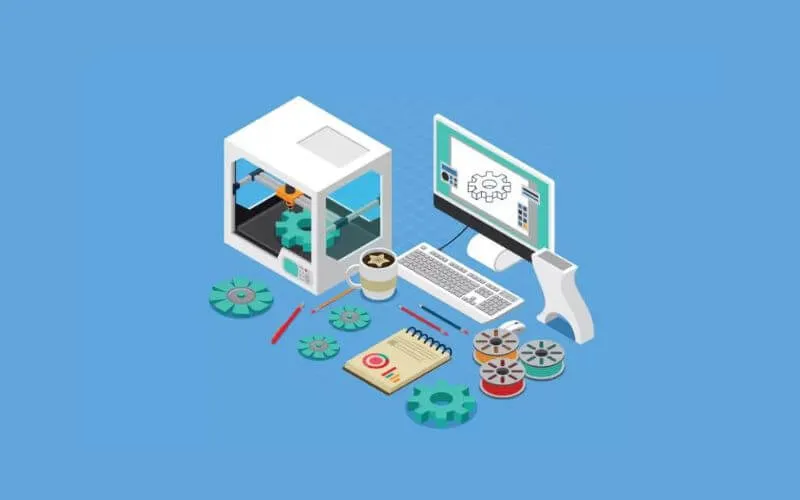11 Benefits & Advantages of 3D Printing – 3D Printing is a manufacturing technique that proceeds by adding material. It is said to be additive, unlike machining, a technique that proceeds by removing material. 3d printing makes it possible to produce spare parts, everyday objects or even prototypes intended for testing.
It all starts with a computer file that breaks the object down into slices and represents it in three dimensions. Then, this information is transferred to a 3d printer which will proceed with the manufacturing by adding successive layers. It is a fast and reliable technology with many advantages. Find in this article the advantages of 3d printing.
Table of Contents
11 Advantages of 3D printing
The Production time
Developed in several sectors of activity, 3d printing is an additive manufacturing technology. It is much faster than more traditional printing methods. In injection for example, the manufacturing time for the mold can last several months. With this time saving, the object can be modified on finding an error, it can even be reprinted if necessary withthe various improvements.
You can request the estimate of your 3d printing on an online service. In the product prototyping process, the speed of production in 3d printing is a big advantage.
The Speed of printing
Are manufactured in 3d printing, functional and finished parts whose mechanical characteristics and resistances are close to machining. In the traditional manufacturing process, it is sometimes necessary to go through several stages.
However, when it comes to additive manufacturing, there is no question of creating a mould, you just have to create the 3d model of your idea and the printing is done in a single phase. This process will only take youa few daysinstead of weeks or months.
Modification and freedom of design
One of the great advantages of 3d printing isfreedom of design. 3d printing is done based on a 3d computer file transmitted to the printer. The 3d file tells the printer all the geometries, shapes and path it will have to perform. It allows you to create and recreate all your ideas by transforming them into real objects.
Even the most complex geometries then become accessible. Additive manufacturing allows the customer tocustomize the manufacture of his productup to the last moment and with the smallest details.
Flexibility in production
Unlike the traditional manufacturing process, 3d printing is a much more flexible and free manufacturing process. It is common to make rectifications and modifications in the manufacturing sector. These changes can have impacts both on the manufacturing time and on the manufacturing cost.3D printingenables the production of complex, custom parts and also opens up exciting possibilities for product customization and personalization. Additive manufacturing makes it possible to anticipate these possible changes.
Manufacture of complex parts
3d printingmakes it possible to manufacture parts with complex geometries and shapes such as arcs or dome-shaped figures. Shapes that are difficult, if not impossible, to achieve with traditional methods.
Structure optimization
Thanks to the specificities of design by 3d printing, it is possibleto optimize already existing productsby reworking their structure. With additive manufacturing, aspects like weight, sturdiness and assemblies can all be worked on. Thus, depending on the parts, there are different types of optimization.
We citetopological optimization.It is a mathematical method which makes it possible to optimize the distribution of matter over a constrained space. There is alsothe optimization of the structure.At this time, the characteristics of the material are all essential elements to take into account.
3d printing makes it possible to create one-piece products that do not require additional assembly after printing.
Mass customization
For many industries, it can be an advantage. When it comes to mass customization, 3d printing has economic advantages. Additive manufacturing does not require specific molds or tools that traditional means can rely on.
Here, the customer’s choice is directly taken into account in the 3d file, to be put into production instantly withthe implementation of digital tools. With digital manufacturing, it is easy to adapt a3d designusing modeling software while printing different versions of the same product.
Wide variety of materials and technologies
Diverse are the existing technologies and materials.From plastic to resinto metal, many materials can now be used on printers. In order to have advanced mechanical properties, high performance materials are used. Among these, you have:
- Ultrasint® PA11 ESDwith its electrostatic discharge properties,
- Ultrasint® PA11 CFreinforced with carbon fibers for more rigidity,
- Ultrasint® PA11 & MJF PA 11two different biosourced powders with stiffness properties,
- Ultra® PA6 FRwith its flame retardant properties,
- Ultrasint® PA6 MFfor more resistance,
- Ultrasint® TPU88A & TPU01which combines flexibility and resistance.
The chemical and thermal resistance, the rigidity of the parts are characteristics that are perfectly accessible with additive manufacturing technologies.
Reduce Waste
3d printingreduces waste. During the 3d printing process, only the amount of the material needed for the design of the object will be used. This advantage is not present in many fabrication techniques.
Supply chain optimization
When talking about the advantage of 3d printing,supply chain optimizationis not the first benefit that comes to mind, but it should. This printing technique can become a huge advantage and help you rethink your supply chain as well as your strategy. It is a way to improve your storage system through a digital inventory.
This is a system that will allow you to simply create your parts on demand and print them when the need arises. This can become for you, a way to create spare parts in 3d printing.
The cost of printing
3d printing includesseveral technologiesto meet different needs. Several factors such as the technology used and the material influence the printing price as well as several other factors which depend on the said model. Compared to traditional machining, only one person is needed to 3d print an object, which reduces labor costs.


